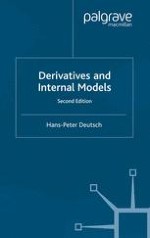2002 | OriginalPaper | Buchkapitel
Principle Component Analysis
verfasst von : Hans-Peter Deutsch
Erschienen in: Derivatives and Internal Models
Verlag: Palgrave Macmillan UK
Enthalten in: Professional Book Archive
Aktivieren Sie unsere intelligente Suche, um passende Fachinhalte oder Patente zu finden.
Wählen Sie Textabschnitte aus um mit Künstlicher Intelligenz passenden Patente zu finden. powered by
Markieren Sie Textabschnitte, um KI-gestützt weitere passende Inhalte zu finden. powered by
In addition to the autoregressive models described above, which are used for instance in the form of GARCH models when modeling volatility, a further technique of time series analysis, called principle component analysis (abbreviated as PCA), is widely applied in the financial world. This technique is employed in the analysis of term structure evolutions, for instance. As mentioned in the introduction of Chapter 15 on term structure models, the approach described in Section 27 in which the term structure was constructed by interpolating between vertices is usually not used to model the (stochastic) dynamics of the term structure. Rather than modeling the interest rate at the vertices as risk factors, the stochastic evolution of the term structure is reduced to a small number of stochastic variables (one, two and sometimes three) which act as the driving factors of the entire term structure. This approach has its justification in principle component analysis. Principle component analysis is a statistical technique which extracts the statistical components from the time series which are most relevant for the dynamics of the process in order of their importance. By means of this method applied to interest rates, it can be shown that usually more than 90% of the term structure’s dynamics can be ascribed to the one or two most important components.
